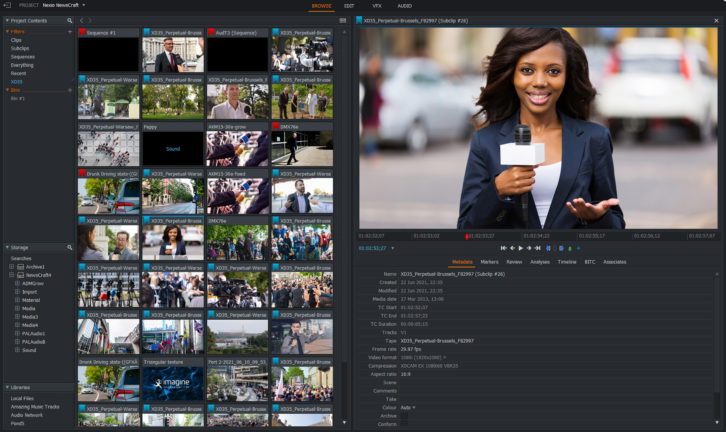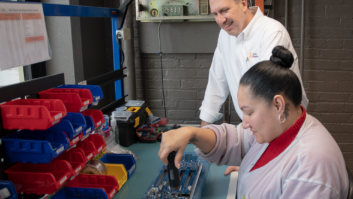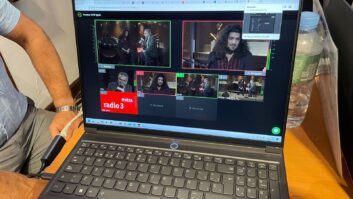Apart from those very rare opportunities to start a news operation from a blank sheet of paper, in most cases, talking about technology for news production means a refresh, an update. Whatever comes next must build on what we have today ― not sweep it all away.
An existing broadcast newsroom will have well-established workflows and journalistic practices. While the latest iteration of technology may help refine those to deliver greater efficiencies, it simply isn’t practical to make wholesale, dramatic changes in a high-pressure working environment.
But no news organisation can afford to stand still. To thrive in an increasingly competitive market, today’s newsroom must:
- generate more content
- disseminate it more widely
- do it faster
- and do it with fewer people and resources.
As well as all the content generated as each story arises, there will be an archive of past content. This is one of the newsroom’s greatest assets. Provided you can find it, you can use archive footage to put today’s events into perspective.
The better the access to the archive, the more engaging will be today’s journalistic output. That translates directly into audience satisfaction, a rise in audience numbers, and ultimately an increase in revenues. There may be a secondary source of revenue in making the archive available to other users, or direct to subscribers.
How can technology help?
The answer lies in automation. But also, and more importantly, in supporting journalists, editors and producers with the tools to get closer to the heart of the story, to help them tell their story in a uniquely clear way ― beating competitors to audience share by being a better, more trusted source of news.
These efficiency-driving tools will also make it easier for stories to be repurposed to multiple outlets: as video packages with introductory script for broadcast; as video and text for the web; text teasers on Twitter; short TikTok, Instagram or Facebook videos and more. The system should allow journalists to make the editorial decisions, with the platform automating the reformatting and transcoding for delivery.

At the heart of the news production system must be creative tools that allow journalists to assemble the story quickly, accurately and imaginatively. Those tools must also be accessible from wherever journalists are, not only allowing stories to be packaged and cut from location, but also empowering home working ― which continues to be a critical requirement in many parts of the world.
The workstation will be more than just a simple and fast editor. As we have seen, the best way of telling a story is to put it into context, which means finding the right associated material. Rich content searching depends upon comprehensive metadata and powerful research tools tightly integrated across both NRCS and MAM systems.
So the next-generation platform will have to automate the production of metadata. Accurate AI tools are invaluable here. Speech-to-text transcription means that every word of every story will be searchable: if you want to find out what a politician has said on a subject in the past, this will allow you to locate every instance.
Additionally, AI will allow practical video analysis. That will identify people and locations, but also relative moods through facial expressions and gestures. Combined with the speech to text, the newly enriched search capabilities will boost the editorial output.
Because the archive is so critical to the newsroom, the technology platform should incorporate tools to batch process the back catalogue as well as capturing metadata from new content.
What about the cloud?
Any news operation undertaking a technology refresh today should certainly include a consideration for cloud as part of their planning. With cloud comes speed of new services, high scalability, and the confidence in a highly available environment. The inherent accessibility of cloud is also realised with remote operations.
Ultimately, you should only invest in the next generation of technology after a careful cost/benefit analysis. The perfect solution will allow you to do more while costing less. For some, that will mean a greater use of the cloud, with consequent savings on machine room real estate, power and IT maintenance skills. For others, the traditional architecture of servers, routers and connectivity will deliver the right performance for the right total cost of ownership.
There is no right answer to whether the technology should be cloud-based, on premises or a hybrid. This is an editorial issue as well as a technological one. Some news directors may prefer gradual exposure to the cloud, so the technology platform must be built on virtualised machines, capable of implementation wherever it is needed.
Whatever the conclusion, it is vital that you do not lose sight of the critical, central goal: to support and strengthen your editorial voice while upholding a high journalistic integrity. The technology is there to serve.







